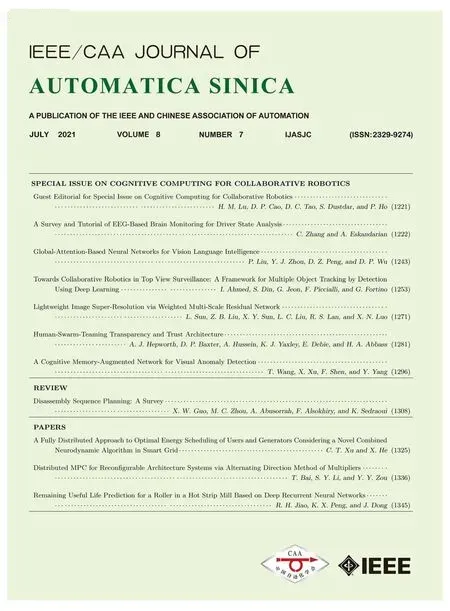Guest Editorial for Special Issue on Cognitive Computing for Collaborative Robotics
Huimin Lu, Dongpu Cao, Dacheng Tao,, Schahram Dustdar,, and Pinhan Ho,
Cognitive Computing breaks the boundary between two separate fields, neuroscience and computer science. It paves the way for machines to have reasoning abilities which is analogous to human. The research field of cognitive computing is interdisciplinary, and uses knowledge and methods from many areas such as psychology, biology, signal processing, physics, information theory, mathematics, and statistics. The development of cognitive computing will keep cross-fertilizing these research areas. However, in collaborative robotics applications there still remain many open problems for using cognitive computing theories.Technologies like computational cognition and perception(CCP) and computational neuroscience (CN) are driving as the best tools for upgrading the robots with near human intelligence, which can be intended to physically interact with humans in a shared workspace.
The aim of this special issue is to collect the state-of-the-art contributions on the CN, CCP, computer vision, natural language processing, human action analysis, and related applications in robotics. The response to our call for this special issue was overwhelming. Thanks to the great support from the Editor-in-Chief, Prof. Mengchu Zhou, and the dedicated work of numerous reviewers, we accepted 6 excellent articles covering various topics in industrial and smart city security. In the following, we will introduce these articles and highlight their main contributions.
In the survey paper “A Survey and Tutorial of EEG-Based Brain Monitoring for Driver State Analysis”, Zhang and Eskandarian discuss EEG-based driver state detection systems and their corresponding analysis algorithms over the last three decades. It is concluded that the current EEG based driver state monitoring algorithms are promising for safety applications. However, many improvements are still required in EEG artifact reduction, real-time processing, and betweensubject classification accuracy.
In the paper “Global-Attention-Based Neural Networks for Vision Language Intelligence”, Wuet al. propose a novel global-attention based neural network (GANN) for vision language intelligence, specifically, image captioning (language description of a given image).
In the paper “Towards Collaborative Robotics in Top View Surveillance: A Framework for Multiple Object Tracking by Detection Using Deep Learning”, Fortinoet al. propose a collaborative robotics framework that can assist in the detection and tracking of multiple objects in top view surveillance.
In the paper “ Lightweight Image Super-Resolution via Weighted Multi-scale Residual Network”, Luoet al. propose a fast and lightweight framework, named weighted multi-scale residual network (WMRN), for a better tradeoff between SR performance and computational efficiency.
In the paper “Human-Swarm-Teaming Transparency and Trust Architecture”, Abbasset al. propose a portfolio of definitions for the vital concept of transparency, and its tenets interpretability, explainability, and predictability, within the setting of human-swarm-teaming (HST). The proposed architecture answers the question of “how” to develop transparency in HST, providing a systems approach to enabling state-of-the-art.
In the paper “A Cognitive Memory-Augmented Network for Visual Anomaly Detection”, Xuet al. propose a novel deep neural network (DNN) based model termed cognitive memory-augmented network (CMAN) for the visual anomaly detection problem. The proposed CMAN model assumes that the visual analysis system imitates humans to remember normal samples and then distinguishes abnormal events from the collected videos.
We would like to express our sincere gratitude to all the authors for submitting their papers and to the reviewers for their valuable comments and suggestions that significantly enhanced the quality of these articles. We are also grateful to Prof. Mengchu Zhou, the Editor-in-Chief of theIEEE/CAA Journal of Automatica Sinica, for his great support throughout the whole review and publication process of this special issue,and, of course, the editorial staff. We hope that this special issue will serve as a useful reference for researchers,scientists, engineers, and academics in the field of cognitive robotics.
 IEEE/CAA Journal of Automatica Sinica2021年7期
IEEE/CAA Journal of Automatica Sinica2021年7期
- IEEE/CAA Journal of Automatica Sinica的其它文章
- Remaining Useful Life Prediction for a Roller in a Hot Strip Mill Based on Deep Recurrent Neural Networks
- Disassembly Sequence Planning: A Survey
- A Cognitive Memory-Augmented Network for Visual Anomaly Detection
- Human-Swarm-Teaming Transparency and Trust Architecture
- Lightweight Image Super-Resolution via Weighted Multi-Scale Residual Network
- Towards Collaborative Robotics in Top View Surveillance: A Framework for Multiple Object Tracking by Detection Using Deep Learning
